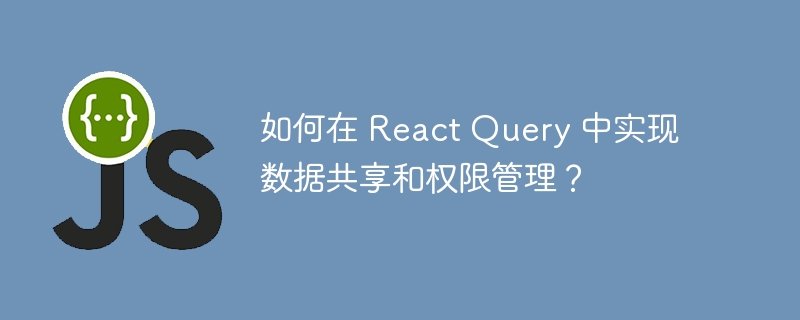

How to implement data sharing and permission management in React Query?
The advancement of technology has made data management in front-end development more complex. In the traditional way, we may use state management tools such as Redux or Mobx to handle data sharing and permission management. However, with the emergence of React Query, we can use it to handle these problems more conveniently. In this article, we will introduce how to implement data sharing and permission management in React Query, and provide specific code examples.
Data sharing refers to sharing the same data source between multiple components in the application. In the traditional way, we need to use a state management library such as Redux to store data in the global state, and then perform fetch and update operations in the required components.
// 使用 Redux 存储数据
import { createStore } from 'redux';
const initialState = {
data: [],
};
function reducer(state = initialState, action) {
switch (action.type) {
case 'UPDATE_DATA':
return {
...state,
data: action.payload,
};
default:
return state;
}
}
const store = createStore(reducer);In React Query, we can use QueryClient to manage data sharing. QueryClient is a global client instance that can be obtained through the useQueryClient hook function in the component.
// 使用 React Query 实现数据共享
import { QueryClient, QueryClientProvider, useQueryClient } from 'react-query';
const queryClient = new QueryClient();
function ExampleComponent() {
const queryClient = useQueryClient();
const handleClick = () => {
queryClient.setQueryData('data', newData);
};
return (
<>
<div>{queryClient.getQueryData('data')}</div>
<button onClick={handleClick}>Update Data</button>
</>
);
}
function App() {
return (
<QueryClientProvider client={queryClient}>
<ExampleComponent />
</QueryClientProvider>
);
}In the above code, we update the shared data through the queryClient.setQueryData method, and obtain the shared data through the queryClient.getQueryData method.
Permission management refers to filtering and controlling data based on the user's identity and permissions. In the traditional approach, we may need to use middleware or perform permission verification in each component.
// 使用 Redux 对数据进行过滤
function MyComponent() {
const { data, user } = useSelector(state => ({
data: state.data,
user: state.user,
}));
const filteredData = useMemo(() => {
return data.filter(item => item.userId === user.id);
}, [data, user]);
// 渲染过滤后的数据
}
// 使用 React Query 对数据进行过滤
function ExampleComponent() {
const queryClient = useQueryClient();
const { data: originalData, user } = useSelector(state => ({
data: state.data,
user: state.user,
}));
const filteredData = useMemo(() => {
return originalData.filter(item => item.userId === user.id);
}, [originalData, user]);
const handleClick = () => {
queryClient.setQueryData('data', filteredData);
};
// 渲染过滤后的数据
}In the above code, we use the useSelector hook function to obtain data in Redux. Then, we use the useMemo hook function to filter the data and only retain data that meets the conditions.
In React Query, we can use the useQueryClient hook function to obtain the QueryClient instance. Then, we update the shared data through the queryClient.setQueryData method, retain the data that meets the conditions, and render it in the component.
To sum up, React Query provides convenient methods to achieve data sharing and permission management. By using QueryClient and useQueryClient hook functions, we can more easily manage the sharing of data and implement permission management by filtering data. These features make it more convenient for us to develop complex front-end applications and improve our development efficiency. I hope this article will help you understand data sharing and permission management in React Query.
The above is the detailed content of How to implement data sharing and permission management in React Query?. For more information, please follow other related articles on the PHP Chinese website!
 Can BAGS coins be held for a long time?
Can BAGS coins be held for a long time?
 Solution to java success and javac failure
Solution to java success and javac failure
 Is Bitcoin trading allowed in China?
Is Bitcoin trading allowed in China?
 Usage of items in python
Usage of items in python
 Solution to the problem that win10 download software cannot be installed
Solution to the problem that win10 download software cannot be installed
 How to enter root privileges in linux
How to enter root privileges in linux
 How to share a printer between two computers
How to share a printer between two computers
 python merge two lists
python merge two lists




